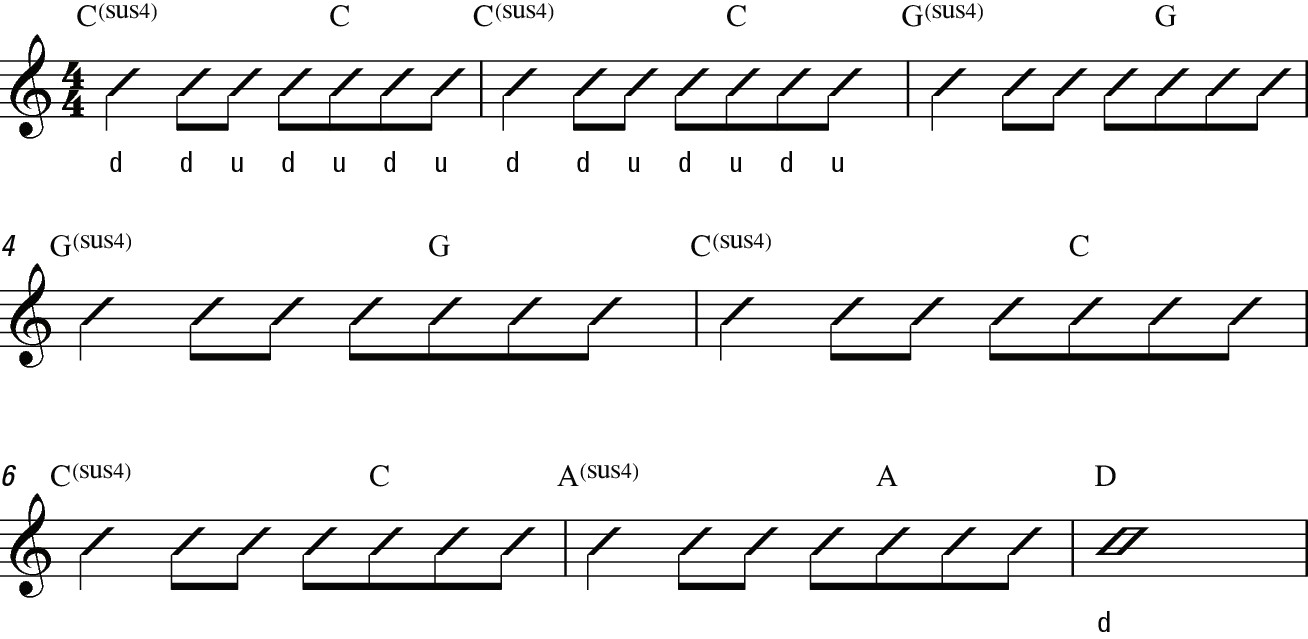Ukulele For Dummies (47 page)
Read Ukulele For Dummies Online
Authors: Alistair Wood

 You can put these chords together to form a Green Day-style progression such as the one in Figure 11-4 (Track 52).
You can put these chords together to form a Green Day-style progression such as the one in Figure 11-4 (Track 52).
Figure 11-4:
Chord progression with power chords.

Building tension: Suspended chords
On the janglier end of the rock spectrum,
suspended chords
are often used to build tension. Suspended chords don't have the note that makes them major or minor. This gives them an incomplete sound which makes the listener crave for the sound to be resolved.
Figure 11-5 has the main suspended chord shapes.
Figure 11-5:
Suspended chord diagrams.

 The commonest move is to go from the suspended chord to the major chord. Figure 11-6 makes this move a number of times to create a Rolling Stones/The Who-style chord progression. When you're listening to this on Track 53, notice how the suspended chords build the tension and how it's released when it moves to the major chord.
The commonest move is to go from the suspended chord to the major chord. Figure 11-6 makes this move a number of times to create a Rolling Stones/The Who-style chord progression. When you're listening to this on Track 53, notice how the suspended chords build the tension and how it's released when it moves to the major chord.
Figure 11-6:
Rock progression using suspended chords.

Strumming Rock and Punk Rhythms
Rock and punk songs aren't known for their inventive use of rhythm. Most of them chug along with something fairly simple. But occasionally someone comes along and puts a bit of funk in their strum. I describe two such innovators in this section.
Bo Diddling
In terms of chords, rock-n-roll great Bo Diddley wrote some of the simplest songs around. Many of his songs consist of one chord for almost the whole length. But he didn't need complicated chords because his strums were so great. He made use of rhythmic
syncopation
(emphasising unexpected beats) to keep things interesting.
 The strumming for this style is really simple (just down, up, down, up and so on). The unusual rhythm is created by releasing the chord straight after strumming it and keeping the strings muted for the other strums (shown by an
The strumming for this style is really simple (just down, up, down, up and so on). The unusual rhythm is created by releasing the chord straight after strumming it and keeping the strings muted for the other strums (shown by an
x
in the notation). Figure 11-7 (Track 54) is the kind of strum Bo Diddley used.
Figure 11-7:
Bo Diddley-style strumming pattern.

Iggy Popping
 Figure 11-8 (Track 55) contains a two-bar strumming pattern that's recognisable from Iggy Pop's âLust for Life'.
Figure 11-8 (Track 55) contains a two-bar strumming pattern that's recognisable from Iggy Pop's âLust for Life'.
As in the preceding section, you want to release the strings just after you strum, but this time you're not strumming all the beats. Follow the strumming directions under the tab to get a sense of when to strum and when to keep quiet.
Figure 11-8:
Iggy Pop-style strumming pattern.

 This pattern is very adaptable; it works really well for rockabilly, punk and up-tempo blues songs.
This pattern is very adaptable; it works really well for rockabilly, punk and up-tempo blues songs.
Riffing Your Way to Rock Heaven
Riffs
are short phrases that are played repeatedly. Many of the most famous rock songs of all time are based on riffs, including the Rolling Stones' â(I Can't Get No) Satisfaction', Nirvana's âCome As You Are' and Muse's âSupermassive Black Hole'.
 Because they're so iconic and recognisable, transferring these riffs to ukulele is great fun. People don't expect to hear them on the uke, and so you often get a âAre you really playing Metallica on the ukulele?' response!
Because they're so iconic and recognisable, transferring these riffs to ukulele is great fun. People don't expect to hear them on the uke, and so you often get a âAre you really playing Metallica on the ukulele?' response!
